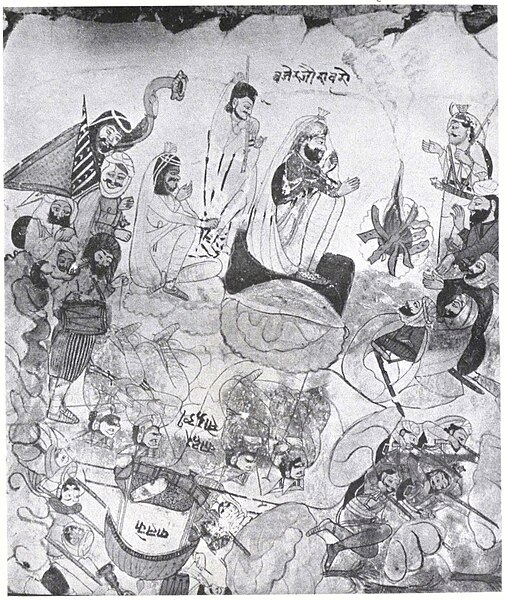File:'Fighting and taking policy decisions', from a painted scroll documenting the joint Dogra-Sikh invasions of Ladakh, Baltistan, and Western Tibet, ca.1840's.jpg

Original file (2,878 × 3,418 pixels, file size: 3.09 MB, MIME type: image/jpeg)
Captions
Captions
Summary[edit]
| Description'Fighting and taking policy decisions', from a painted scroll documenting the joint Dogra-Sikh invasions of Ladakh, Baltistan, and Western Tibet, ca.1840's.jpg |
English: 'Fighting and taking policy decisions', from a painted scroll documenting the joint Dogra-Sikh invasions of Ladakh, Baltistan, and Western Tibet, ca.1840's. Zorawar Singh Kahluria was a general of the Dogra Dynasty, whom at that time were vassals to the Sikh Empire (who were their suzerain). He invaded and conquered the Namgyal Dynasty of Ladakh (annexed to the Sikh Empire in 1842) and the Maqpon Dynasty of Baltistan (annexed to the Sikh Empire in 1845). He led an invasion into Tibet (1841–1842) but was driven back by the forces of the Qing Dynasty, in-turn driving back their invasion of Ladakh.
Plate No. 4: Fighting and taking policy decisions (General Zorawar Singh consulting his lieutenants including Wazir Uttam Padhiar); standard-bearers, buglers and drummers are also seen standing nearby. Description of the painted scroll (written by C. L. Datta and published in 'General Zorawar Singh: His Life and Achievements in Ladakh, Baltistan and Tibet', 1984): Pages 108–124:Page 6: Pages 9–10: Pages 13:
|
| Date | likely ca.1840's |
| Source | Photographs of artwork published in a book titled 'General Zorawar Singh: His Life and Achievements in Ladakh, Baltistan and Tibet' (1984) by C. L. Datta, viewable at: [1] |
| Author | possibly Ganga Ram 'Nakashi' (alt. spelt as Ganga Ram 'Naqqashi') |
Licensing[edit]
|
This is a faithful photographic reproduction of a two-dimensional, public domain work of art. The work of art itself is in the public domain for the following reason:
The official position taken by the Wikimedia Foundation is that "faithful reproductions of two-dimensional public domain works of art are public domain". This photographic reproduction is therefore also considered to be in the public domain in the United States. In other jurisdictions, re-use of this content may be restricted; see Reuse of PD-Art photographs for details. {{PD-Art}} template without license parameter: please specify why the underlying work is public domain in both the source country and the United States
(Usage: {{PD-Art|1=|deathyear=''year of author's death''|country=''source country''}}, where parameter 1= can be PD-old-auto, PD-old-auto-expired, PD-old-auto-1996, PD-old-100 or similar. See Commons:Multi-license copyright tags for more information.) | |||||
File history
Click on a date/time to view the file as it appeared at that time.
| Date/Time | Thumbnail | Dimensions | User | Comment | |
|---|---|---|---|---|---|
| current | 17:05, 13 April 2024 |  | 2,878 × 3,418 (3.09 MB) | MaplesyrupSushi (talk | contribs) | Uploaded a work by possibly Ganga Ram 'Nakashi' (alt. spelt as Ganga Ram 'Naqqashi') from Photographs of artwork published in a book titled 'General Zorawar Singh: His Life and Achievements in Ladakh, Baltistan and Tibet' (1984) by C. L. Datta, viewable at: [https://www.claudearpi.in/wp-content/uploads/2021/01/1984-General-Zorawar-Singh-his-life-and-achievements-in-Ladakh-Baltistan-and-Tibet-by-Datta.pdf] with UploadWizard |
You cannot overwrite this file.
File usage on Commons
There are no pages that use this file.
Metadata
This file contains additional information such as Exif metadata which may have been added by the digital camera, scanner, or software program used to create or digitize it. If the file has been modified from its original state, some details such as the timestamp may not fully reflect those of the original file. The timestamp is only as accurate as the clock in the camera, and it may be completely wrong.
| Orientation | Normal |
|---|